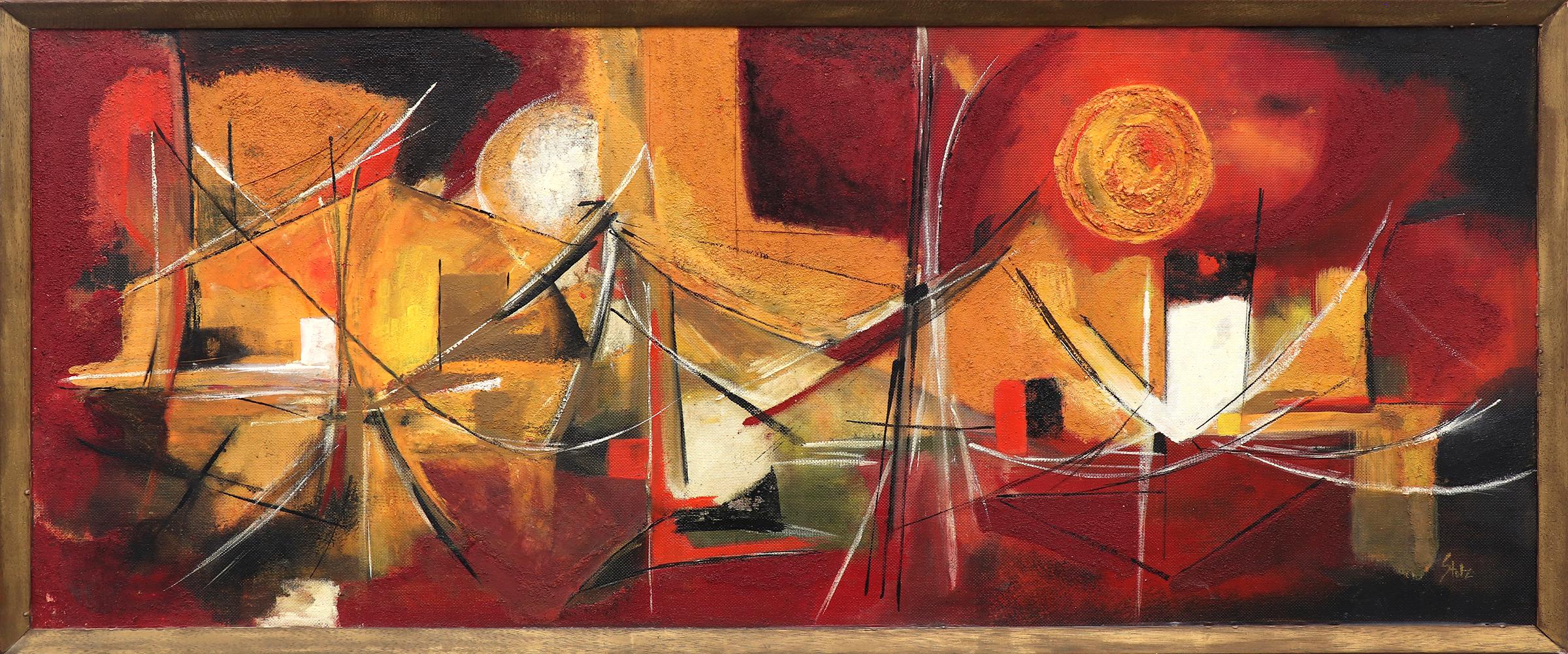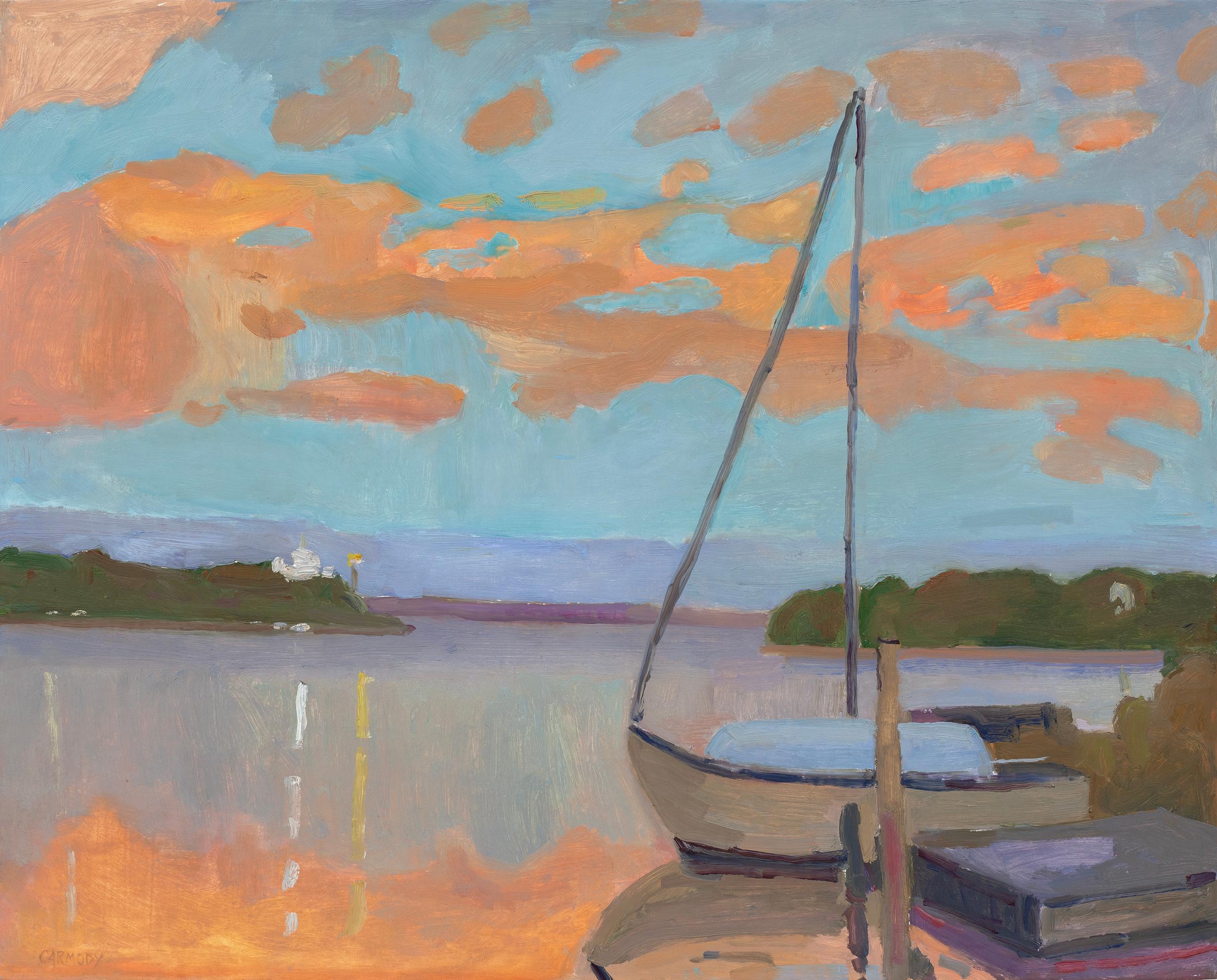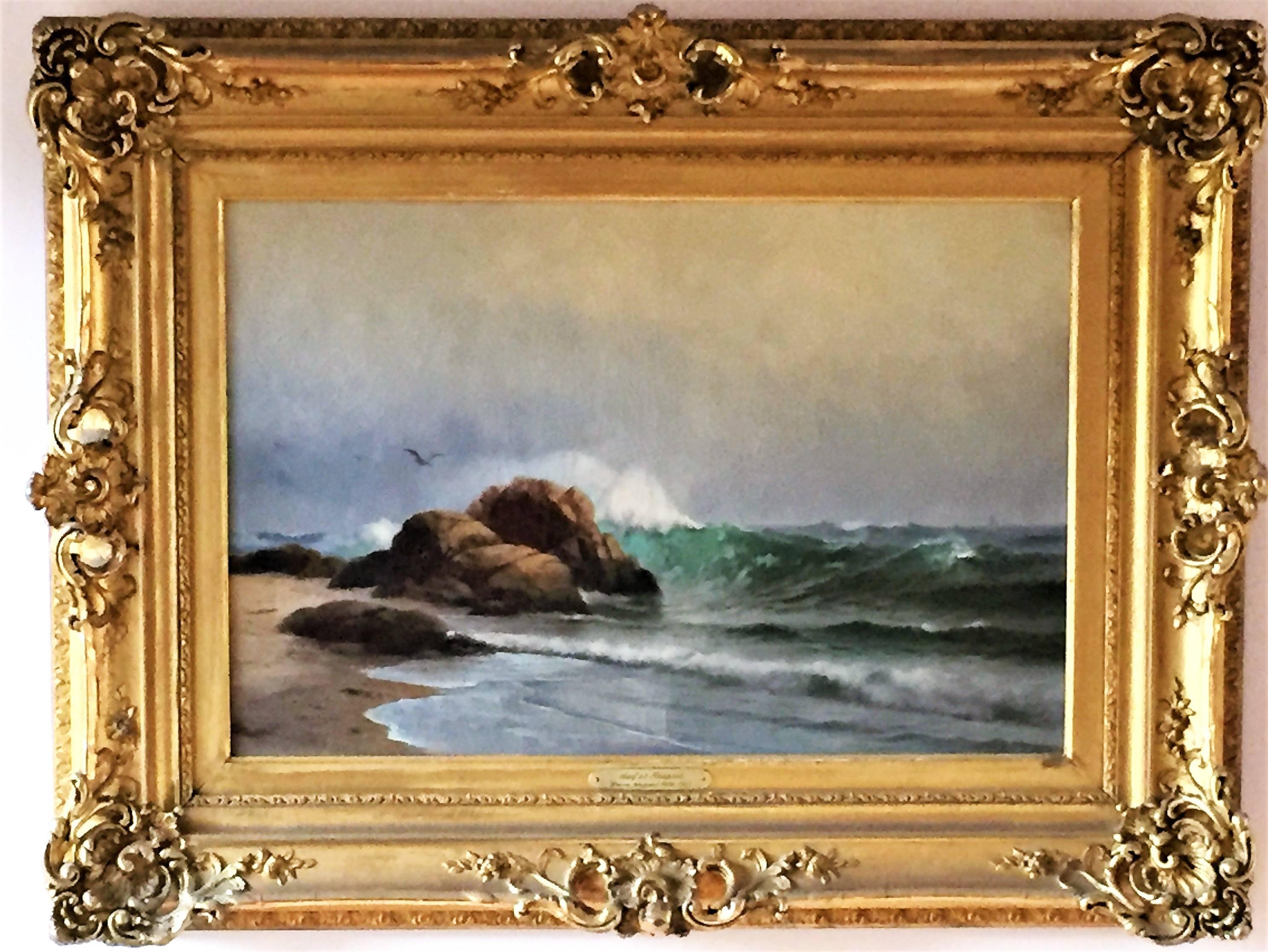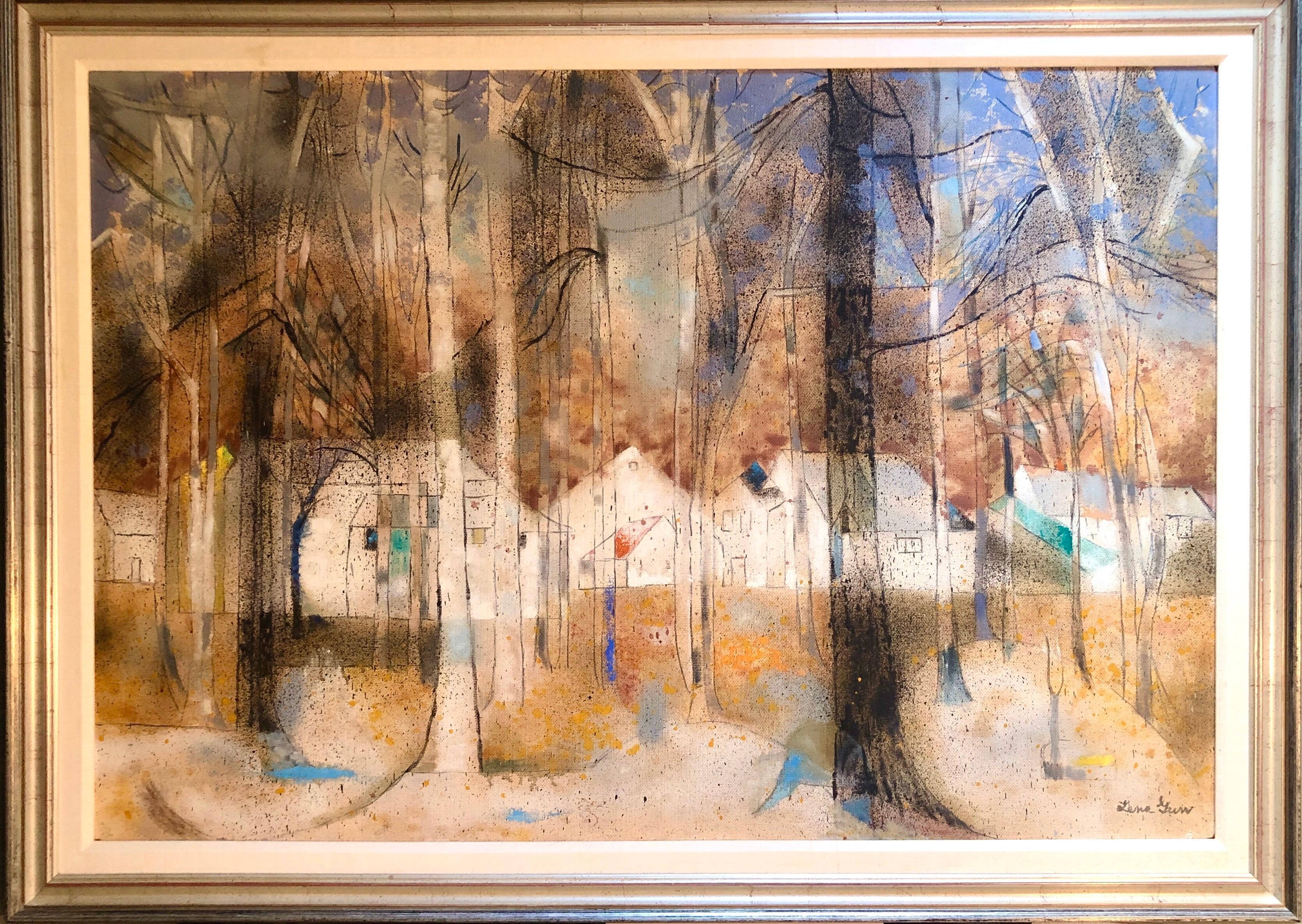Items Similar to Southwestern Landscape Painting, Lightning Storm over Mountains, Semi Abstract
Video Loading
Want more images or videos?
Request additional images or videos from the seller
Morton Lawrence SchneiderSouthwestern Landscape Painting, Lightning Storm over Mountains, Semi Abstract
About the Item
Original vintage painting of a Lightning Storm, Southwestern Mountain Landcape. Oil painting on textured board by Morton Lawrence Schneider (1919-2000). This large scale semi abstract artwork in horizontal format depicts an abstract southwestern landscape, overlooking a valley with mountains in the background as a lighting storm moves over the mountains - likely of New Mexico. Presented in a black frame, outer dimensions measure 19 ¾ x 51 ⅞ x 1 ¼ inches. Image size is 15 ½ x 47 ½ inches. This size is well suited for display over a sofa, console table or mantle.
Provenance: Private collection, Denver Colorado
- Creator:Morton Lawrence Schneider (1919 - 2000)
- Dimensions:Height: 19.75 in (50.17 cm)Width: 51.75 in (131.45 cm)Depth: 1.25 in (3.18 cm)
- Medium:
- Movement & Style:
- Period:
- Condition:Painting is clean and in good condition - please contact us if you would like a detailed condition report.
- Gallery Location:Denver, CO
- Reference Number:
About the Seller
5.0
Platinum Seller
These expertly vetted sellers are 1stDibs' most experienced sellers and are rated highest by our customers.
Established in 1979
1stDibs seller since 2013
265 sales on 1stDibs
Typical response time: 5 hours
- ShippingRetrieving quote...Ships From: Denver, CO
- Return PolicyA return for this item may be initiated within 7 days of delivery.
More From This SellerView All
- Mid Century Modern Abstracted Cityscape Oil Painting, American Modern, Red BlackLocated in Denver, COMid 20th century oil and spackle painting featuring an abstracted cityscape with a bridge and buildings by Henriette "Yetti" Stolz. Signed by the artist in the lower right margin. Pa...Category
Mid-20th Century American Modern Abstract Paintings
MaterialsOil, Board, Putty
- American Modernist Abstract Landscape Oil Painting of Trees, Yellow Orange BlueLocated in Denver, COMid 20th Century abstracted landscape pen and oil painting with trees by American Modernist Henriette "Yetti" Stolz, signed on the back of the painting. Portrays a modernist landscape of a forest with trees, painted in shades of gold, brown, orange, and blue. Presented in a vintage frame measuring 30 ¾ x 36 ¼ inches. Image measures 30 ¼ x 35 ¾ inches. Provenance: Estate of the Artist, Henriette "Yetti" Stolz Painting is in good condition - please contact us for a detailed condition report. About the Artist: Henriette “Yetti” Stolz was born in Serbia in 1935 ( and is still living ). Her family emigrated to Denver, Colorado, in the early 1950s after WWII and she attended East High School before studying art at Colorado College, in Colorado Springs in the mid to late 50s. While there studying she would have been exposed to modernist artists working both at the college ( ie. Mary Chenoweth...Category
Mid-20th Century American Modern Abstract Paintings
MaterialsCanvas, Ink, Oil
- Central City, Colorado, 1950s Modernist Cityscape Oil Painting with BuildingsLocated in Denver, COOil on canvas modernist city scape painted circa 1950 by Paul K Smith (1893-1977) titled Central City, Colorado. Portrays a city scene of historic buildin...Category
1950s American Modern Landscape Paintings
MaterialsCanvas, Oil
- Old Mine and Houses, Cortez Colorado, Modernist Abstract Landscape WatercolorBy Richard AyerLocated in Denver, CO20th century modernist watercolor painting depicting an old mine and houses in Cortez, Colorado by Richard K. Ayers with colors of blue, green, gold, and brown. Presented in a custom frame with all archival materials, outer dimensions measure 36 ½ x 30 ½ x ¾ inches. Image size is 24 ¾ x 18 ¾ inches. Painting is clean and in very good vintage condition. About the Artist: Richard K. Ayers (1921-2003) studied art at Miami University...Category
20th Century American Modern Abstract Paintings
MaterialsWatercolor
- Ed Sketching at Red Rocks, Vintage 1940s Original Mountain Landscape, ColoradoBy Vance KirklandLocated in Denver, COOriginal vintage 1940s Modernist Landscape painting of Red Rocks Park, Colorado by Vance Kirkland (1904-1981). Titled, "Ed (Hicks) Sketching at Red Rocks". This regionalist mountain landscape painting is set near Red Rocks Park, Morrison, Colorado (just west of Denver). The figure in the painting is of Kirkland's friend, Ed Hicks. Watercolor on paper, signed and dated, January 1943, lower left and titled verso by the artist. Painted in colors of red, brown, blue, and green. Presented in a custom gold leaf frame, outer dimensions measure 34 ¾ x 42 ⅞ x 1 ¼ inches. Painting as shown within the mat and frame measures 21 x 29 inches. Provenance: Private Collection, Denver, Colorado About the Artist: Variously referred to as the “Father of Modern Colorado Painting,” “Dean of Colorado Artists” and “Colorado’s pre-eminent artist,” Kirkland was an inventive, visionary painter who spent fifty-two years of his fifty-four year career in Denver. Of the approximately 1,200 paintings he created, about 550 from the first half of his career (1927-1953) are water-based media: acquarelle, gouache, casein and egg tempera, with a few oils. In the latter half of his career (1953-1981) he used oil and his unique oil and water mixture. He also produced five hundred drawings and some ten prints, mostly lithographs on stone, while also engaged in teaching full-time for most of the period. To show people “something they have never seen before and new ways to look at things,” he felt he needed to preserve his artistic freedom. Consequently, he chose to spend his entire professional career in Denver far removed from the established American art centers in the East and Midwest. “By minding my own business and working on my own,” he said, “I think it was possible to develop in this part of the country… I’ve developed my kind of work [and] I think my paintings are stronger for having worked that way.” The geographical isolation resulting from his choice to stay in Colorado did not impede his creativity, as it did other artists, but in fact contributed to his unique vision. The son of a dentist, who was disappointed with his [son’s] choice of art as a career, Kirkland flunked freshman watercolor class in 1924 at the Cleveland School of Art (now the Cleveland Institute of Art) for putting colors into his landscapes that did not exist in nature and for competing colors. Not dissuaded, he won first prize for his watercolors in his junior and senior years. [While in Cleveland,] he studied with three influential teachers. Henry Keller, included in the prestigious New York Armory Show in 1913, introduced him to designed realism which he later used in his Colorado landscapes in the 1930s and 1940s. His other teachers were Bill Eastman, who studied with Hans Hofmann and appreciated all the new movements in modern art, and Frank Wilcox, a fine watercolorist. While a student at the Cleveland School of Art, Kirkland concurrently took liberal arts courses at Western Reserve and the Cleveland School of Education and taught two freshman courses in watercolor and design, receiving his diploma in painting from the school in 1927 by doing four years of work in three. The following year he received a Bachelor of Education in Art degree from the same institution. In 1929 he assumed the position of founding director of the University of Denver’s School of Art, originally known as the Chappell School of Art. He resigned three years later when the university reneged on its agreement to grant its art courses full recognition toward a Bachelor of Arts degree. His students prevailed on him to continue teaching, resulting in the Kirkland School of Art which he opened in 1932 at 1311 Pearl Street in Denver. The building, where he painted until his death in 1981, formerly was the studio of British-born artist, Henry Read, designer of the City of Denver Seal and one of the original thirteen charter members of the Artists’ Club of Denver, forerunner of the Denver Art Museum. The Kirkland School of Art prospered for the next fourteen years with its courses accredited by the University of Colorado Extension Center in Denver. The teaching income from his art school and his painting commissions helped him survive the Great Depression. The U.S. Treasury Department’s Section of Fine Arts commissioned from him two post office murals, Cattle Roundup (1938, Eureka, Kansas), and Land Rush (1940, Sayre, Oklahoma). He also did murals for several Denver clients: the Gerald Hughes mansion (1936, later demolished), Arthur Johnson home (1936-37, Seven Drinks of Man), Albany Hotel (1937, later demolished), Neustetter’s Department Store (1937, “History of Costume,” three of five saved in 1987 before the building interior was demolished in advance of its condo conversion), and the Denver Country Club (1945, partially destroyed and later painted over). In 1953 the Ford Times, published by the Ford Motor Company, commissioned Kirkland along with fellow Denver artists, William Sanderson and Richard Sorby, to paint six watercolors each for the publication. Their work appeared in articles [about] Colorado entitled, “Take to the High Road” (of the Colorado Rockies) by Alicita and Warren Hamilton. Kirkland sketched the mountain passes and high roads in the area of Mount Evans, Independence Pass near Aspen, and Trail Ridge Road in Rocky Mountain National Park. In 1946 Kirkland closed his art school when the University of Denver rehired him as director of its School of Art and chairman of the Division of Arts and Humanities. In 1957...Category
1940s American Modern Landscape Paintings
MaterialsWatercolor
- Central City, Colorado, 1950s Semi-Abstract Cityscape Gouache Painting, Red BlueLocated in Denver, CO'Central City, Colorado' by Leonard Silverstein is an original gouache on paper from 1954. Hand signed, titled, and dated by the artist in the lower right...Category
1950s American Modern Landscape Paintings
MaterialsGouache, Archival Paper
You May Also Like
- Head to Sea, Modernist sailing sceneBy Ralph Eugene Della-VolpeLocated in Greenwich, CTA vibrant and yet romantic sailing scene which was a favorite series by Della-Volpe. His compelling colorist approach has made his works desirable as he was one of the few artists post-war to be representative in style like Milton Avery and Wolf Kahn. Head to Sea has the hallmark intense and lovely coloration for which Della-Volpe is known. He came out of Abstract Expressionism in the New York school but then pivoted, like Milton Avery to representational, colorist work. The frame is a silvered gold leaf float frame of quality and has a rubbed, antiqued surface...Category
Early 2000s American Modern Abstract Paintings
MaterialsOil, Board
- "Orange Clouds" American contemporary seascape with sailboat, eveningBy Kelly CarmodyLocated in Sag Harbor, NY"Orange Clouds" is an American Modern contemporary seascape with sailboat, evening. Kelly Carmody’s work has been widely exhibited and collected. One of her major figurative works w...Category
21st Century and Contemporary American Modern Landscape Paintings
MaterialsOil, Panel, Wood Panel, Board
- The Surf at NewportBy Warren W. SheppardLocated in Storrs, CTThe Surf at Newport (Rhode Island). c. 1906. Oil on canvas. 17 x 24 (framed 26 x 34). Lined; extensive craquelure; otherwise fine condition. Housed in an exceptional Louis XV (reviva...Category
Early 20th Century American Modern Landscape Paintings
MaterialsOil
- American Woman Artist Modernist Large Oil Painting Cubist Influenced LandscapeBy Lena GurrLocated in Surfside, FLA beautiful wooded landscape scene with houses and trees. Painted on a masonite board. hand signed lower right. with framers label verso. Framed to 40 X 55 inches. 33 X 48 without the frame and mat. It is not dated. Lena Gurr (1897–1992), was an American woman artist who made paintings, prints, and drawings During the course of her career Gurr's compositions retained emotional content as they evolved from a naturalistic to a semi-abstract cubist style. Born into a Russian-Jewish Yiddish speaking immigrant family, she was the wife of Joseph Biel, also Russian-Jewish and an artist of similar genre and sensibility. Gurr used Lena Gurr as her professional name. After marrying Joseph Biel she was sometimes referred to as Lena Gurr Biel. Biel had been born in Grodno, Poland (later absorbed into Russia) and had lived in England, France, and Australia before coming to New York. An artist, he specialized in landscape paintings and silkscreen printing as well as photography. He studied art at the Russian Academy in Paris. After immigrating to the United States, he studied under George Grosz at the Arts Students League. Gurr was born in Brooklyn and, apart from brief stays in Manhattan and in Paris, lived there her whole life. This painting bears the influence of Lyonel Feininger an influential German American artist. Gurr began studying art at a young age. In 1919 she studied painting and printmaking at the Educational Alliance Art School and between 1920 and 1922 she won a scholarship to attend the Art Students League where she took classes with John Sloan and Maurice Sterne. In 1926 and 1928 Gurr participated in group shows at the Whitney Studio Club in Greenwich Village and in 1928 she also participated in the 12th annual exhibition of the Society of Independent Artists at the Waldorf Roof in New York. (Reviewing this show, Helen Appleton Read, the critic for the Brooklyn Daily Eagle, said "I made three discoveries on my first visit, Thomas Nagel, Eugenie McEvoy and Lena Gurr with two figure compositions which have something of Marie Laurencin or Helene Perdriat quality of naive sophistication.") The Waldorf Roof was a set of rooms on the top floor of the Waldorf Astoria Hotel, one of which had glass sides and a glass roof. The rooms were used for concerts, dances, benefits, and exhibitions.From 1929 to 1931 Gurr took a leave of absence from her teaching position to travel in France with Joseph Biel, an artist whom she had met while studying at the Art Students League. They spent time in Nice and Mentone but mainly in Paris. During the early months of 1931, while she was still abroad, her work appeared in group exhibitions held at the R. H. Macy department store and the Opportunity Gallery (opened by Gifford Beal). In 1932 she participated in three shows: a solo exhibition at the Brooklyn Museum, an annual exhibition of the New York Society of Women Artists, ( Its first president was Marguerite Zorach. Founding members included Agnes Weinrich, Anne Goldthwaite...Category
Mid-20th Century American Modern Landscape Paintings
MaterialsOil, Panel
- Waterfall (Woodstock, New York)By Grace Hill TurnbullLocated in Concord, MAGRACE HILL TURNBULL (1880-1976) Waterfall (Woodstock, New York), c. 1925 Oil on canvas 14 x 20 inches Unsigned PROVENANCE The Maryland Historical Society The work of pai...Category
1920s American Modern Landscape Paintings
MaterialsCanvas, Oil
- Abstract Street (Untitled)By Hananiah HarariLocated in Los Angeles, CAThis painting is part of our exhibition America Coast to Coast: Artists of the 1930s Abstract Street (Untitled), 1939, oil on canvas, signed and dated lower right, 12 x 32 inches; provenance includes a private collection in Venice, California; presented in what is likely the artist's original handmade frame About the Painting The present work is the culmination of a series of mainly horizontal urban abstractions Harari completed between 1937 and 1939. Deeply influenced by Stuart Davis, Harari’s New York streetscapes began with clearly recognizable objects and landmarks as in Into New York (1937 - Collection of the Whitney Museum of American Art), New York Harbor (1937), Up and Downtown (1938), and his other mural proposals for the Nurses Home on Welfare Island (1937) and the Williamsburg Housing Project (1938). At the end of the series, Harari’s vistas became increasingly abstract with broad planes of color representing buildings and streets, the slightest cross-hatching forming a bridge or elevated train track and the vague suggestion of a streetlight looping in the right center of the composition. Figures, birds, and a street vendor’s cart are reduced to pictograms scratched into the surface of the canvas. Abstract Street (Untitled) is among Harari’s most spare works of the 1930s and 1940s and calls to mind the seemingly childlike, but deeply sophisticated works of Paul Klee from the 1920s. It serves as an excellent reminder of why Harari was heralded as one of the earliest members of the American Abstract Artists. About the Artist Hananiah Harari was an artistic polyglot who was equally at home working in styles as diverse as Cubism, Constructivism, Expressionism, Hard Edged Abstraction and trompe l’oeil Realism. A native of Rochester, New York, Harari initially studied as a child at the Memorial Art Gallery in his hometown and later as a scholarship student at the College of Fine Arts at Syracuse University. In 1932, Harari left for Paris where he befriended Nahum Tschacbasov, Benjamin Benno and John Graham and studied at the ateliers of Lhote, Leger and Gromaire. He also studied fresco painting at the Ecole de Fresque. By 1933, Harari had completed enough work and gained a sufficient reputation to have a solo exhibition at the American Club in Paris. The following year, Harari and his childhood friend and fellow artist Herzl Emanuel traveled to Palestine, where the artists worked hard in the orchards and fields of Kibbutz Deganiah, but produced little art. After returning to New York, Harari married Emanuel’s sister, Freda, and set out on the development of what noted scholar Gail Stavitsky has called an “original synthesis of the old and new." Harari became an early member of the American Abstract Artists (AAA), an organization formed to give modernists exhibition opportunities. Harari was also a member of the socially conscious Artist’s Union and the American Artist’s Congress. From 1936 through 1942, Harari worked on the Federal Art Project and assisted Marion Greenwood on a project as part of the Mural Division, but to his disappointment did not lead his own project. During the late 1930s and early 1940s, Harari completed a series of paired paintings with the same subject matter depicted in a Cubist manner and in trompe l’oeil Realism. Harari was acclaimed by Clement Greenberg and six of the artist’s works were selected for the Museum of Modern Art’s important 1943 exhibition American Realists and Magic Realists. During World War II, Harari served in the US Army Air Corps. Following the war, Harari continued to produce fine art while also producing commercial art. During the McCarthy Era, Harari’s progressive politics and leftist leaning art...Category
1930s American Modern Abstract Paintings
MaterialsOil
Recently Viewed
View AllMore Ways To Browse
Horizontal Paint
Horizontal Abstract
Us Mountains
Horizontal Art Framed
Framed Art Horizontal Frame
Abstract Mountain Landscape
Landscape Paintings Evening
Denver Colorado
Horizontal Art Modern
Vintage Landscape Background
Vintage Landscape Backgrounds
Horizontal Landscapes
Southwestern Vintage
Landscape Storm
Southwestern Art
Landscape Horizontal Painting
Colorado Mountain Landscapes
Landscape Oil Painting Storm





